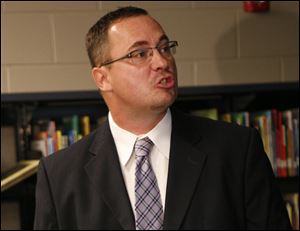
STANDARDIZED TESTING
State issues report cards to criticism
Many local school districts reject lower results as unfair
2/26/2016
Jim Gault, Chief Academic Officer for Toledo Public Schools
THE BLADE
Buy This Image
The state on Thursday released long-awaited Ohio school report cards, a data dump that was met with an avalanche of criticism from local districts and legislators who blasted the frequently changing testing system.
The release marks another complicated, controversial chapter in Ohio standardized testing.

The newly released numbers represent the second half of 2015 data and include the closely watched performance index that marks how well students did on up to 36 indicators, including tests in multiple grades and subjects.
The 2014-2015 school year’s switch to new tests make comparisons to previous report cards difficult. The move to more rigorous exams and decreased levels of student participation lowered many schools’ scores in certain categories, officials said.
SEARCHABLE DATABASE: See how each local school district fared
OHIO DEPT. OF EDUCATION: School Report Card Resources
RELATED CONTENT: Perrysburg officials: PARCC tests caused district grades to fall ■ Sylvania Schools criticize Ohio Report Card ■ Ottawa Hills 1 of 2 to receive all A’s
Some districts, including Toledo Public Schools, are appealing portions of data, meaning report cards are still incomplete.
Toledo repeated its D grade on the performance index — the same as last year — but its percentage score dropped from 69 percent in 2014 to 59 percent in 2015. That put it in the middle of the pack among Ohio’s eight urban districts, which all received D grades on the performance index.
In general, TPS scores dropped by about 30 percent on specific subject and grade tests, said Jim Gault, TPS’ chief academic officer. For example, 39.5 percent of Toledo’s third graders tested at proficient or above levels in math in 2015, compared to 66 percent the year before.
Maumee, Northwood, Oregon, Rossford, Springfield, and Washington Local were among area districts that fell by a letter on the performance index grade.
Perrysburg and Sylvania maintained B’s in that category, but their overall value-added grades, which attempts to measure fourth through eighth graders’ progress in math and reading, decreased sharply.
“The true story in this is the inconsistencies and changes [at the] state level,” Mr. Gault said. “It’s tough when every year it’s something new. … I think that’s why you’re seeing the outcry.”

The state abandoned and dropped funding for the controversial Partnership for Assessment of Readiness for College and Careers, or PARCC, test after one year. It was supposed to tell the state how well schools were meeting new Common Core education standards in math and English and match up with schools in other states.
But it drew suspicion from some parents about the standards, and critics argued the exams were too time-consuming and plagued by technological problems since some students took the tests on computers.
“Some districts and schools may see lower grades,” said Chris Woolard, Ohio Department of Education senior executive director. “We expected this as Ohio raised the bar.”
Mr. Woolard described the delayed, two-part release of report-card data as an “unusual situation,” but defended the use of standardized testing.
“This is still incredibly useful information for educators, communities, parents,” he said, calling the report cards a chance for districts “to reset” expectations based on a higher standard.

Jim Gault, Chief Academic Officer for Toledo Public Schools
At a news conference Thursday in Columbus, State Rep. Teresa Fedor (D., Toledo) and State Board of Education member A.J. Wagner urged the public to ignore the new report-card results, saying they’re from a flawed test the state has already dropped.
“Disproportionate and misleading scores create a perception that does not reflect the reality of our education system in Ohio…,” said Ms. Fedor, a former elementary school teacher. “It’s time to hit the pause button.”
Nearly 99 percent of students took state tests last year, according to the state. But local school officials said a lack of participation negatively affected some scores in measures such as the performance index mark.
Mr. Gault cited participation levels — about 170 Toledo students went untested — among the reasons for lower scores.
TPS and Maumee were among districts whose students took the tests on computers while others took paper versions, and officials contend that also factored in their scores.
“The results are very confusing,” Maumee Superintendent Greg Smith said. “We have good achievement scores and very talented and dedicated staff. This is truly a misrepresentation and does not accurately reflect the quality education students receive at Maumee Schools.”
Perrysburg and Sylvania pre-emptively sent messages to parents and school community members before the report-card release warning that results would be lower this year. District officials cited student participation and the state’s switch to a new test.
“Unfortunately, the data being used is not only very late, it is inaccurate and a large portion of it will not be used any longer in Ohio,” Sylvania Superintendent Scott Nelson wrote in and email Wednesday.
Sylvania dropped from an A to a D for overall value-added, which in 2015 was based on a one-year average instead of several years because of test changes. Perrysburg went from an A to a C.
“When you are using the same test year-in and year-out you get good data. It’s kind of like running the 100 meters and knowing what your time should be at 100 meters, but now you run 100 yards and your results are off. What happened? We worked just as hard,” said Perrysburg Superintendent Tom Hosler.
A C grade in that category reflects one year’s worth of growth, Mr. Woolard said, while an A means a district is exceeding expectations.
“It’s not the end of the world they got a C,” he said.
TPS’ value-added scores were not reported on the cards, because of an appeal filed last month. Last year, it received an A for its overall score in the category.
A safe-harbor provision in Ohio law protects districts from many sanctions based on poor test performance in an attempt to give districts, students, and teachers a chance to adjust to the tests. In most cases, there will be no negative consequences linked to test results through the 2016-2017 school year.
Typically, report card information is released in full in late August or September. Testing upheavals delayed the 2015 data, which came out in two parts. In January, the state released a portion of the report card that included graduation rates.
A replacement test from American Institutes for Research will be administered this year.
The release of the 2015-2016 report cards is expected to be back on schedule, with information available in late summer.
“Future report cards will do a better job of more accurately reporting relevant information to the public,” said Sen. Randy Gardner (R., Bowling Green), who in a written statement expressed disappointment with what he characterized as the unfair reflection the report cards cast on schools.
Blade staff writers Matt Thompson, Jim Provance, Nolan Rosenkrans, and Kyle Rowland contributed to this report.
Contact Vanessa McCray at: vmccray@theblade.com or 419-724-6065, or on Twitter @vanmccray.